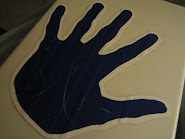In this lesson we will need:
- A small amount of white duct tape (2-4 square inches)
- Our trusty razor knife (Sharpness seeks flesh! be careful!)
- Cutting board
- Our original black eighth note
- The paper template of the eighth note (we made this last lesson but another can easily be recreated if you threw it away!)
I think that covers our supplies. In this section, a bit of a visualistic eye is required, but don't worry, its not hard at all, and the results are amazing, trust me!
First, we need to place our paper template on top of our white duct tape. We are doing this because it will give us an idea about where to make cuts. However, we will need to estimate where our glare or reflections will need to be placed. This is where our visualistic touch comes in.
First, lets place glare on the fat part of our note. So, lay the fat part of the paper template on the white duct tape and cut out a shape which resembles a kidney bean. It should look something like this. (The picture can be somewhat deceiving. For clarity's sake, the cut I made went through the paper and duct tape)

Now, save this piece. We will place it on the note later. Now, we need to create some small glare for the top, swish part of the note.
So, remove your paper template and recenter the swish tail on a clean, unused section of the white duct tape. Here, all we have to do is cut out a significantly smaller version of the swish. It should look like this.

Now, we must place our pieces of glare. In order to give the duct tape note a realistic appearance, we need to take light's nature into account. Generally, light only shines from one source and glare is a result of that emission. This can be seen in the picture below. When we place our glare, we need to place it on the same side of the design. This practice can be best explained by looking at the picture below. You will see that both of the glares are on top of the note. (the light imaginary light is coming from above in this case.)

Congratulations! You now know how to add realistic shading to your duct tape art! Now you can make amazing, eye-snatching duct tape creations! See? I told you it wasn't too hard. It only takes practice! Feel free to try a few of your own ideas out! Please feel free to comment on my tutorials or even share your own ideas!
Be sure to join us for our next lesson! See you soon!








No comments:
Post a Comment